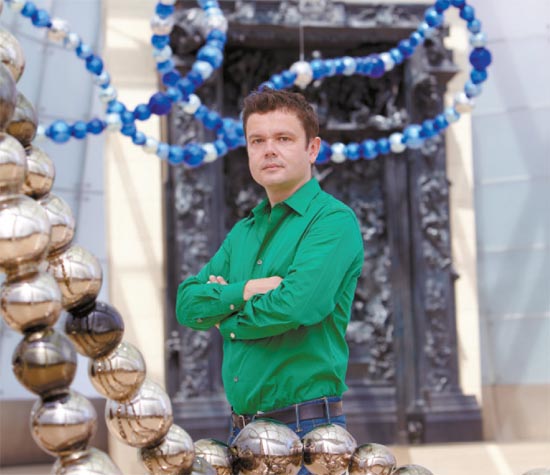Profound and poetic intersect with Othoniel

Jean-Michel Othoniel poses at Plateau in central Seoul with “Self-Standing Knot” in front of him and “The Great Double Lacan’s Knot” hanging in the background. Provided by the gallery
Two glass sculptures hanging at Seoul’s Plateau gallery look like giant beaded necklaces, or strands of DNA, and are part of a mesmerizing new retrospective of French contemporary artist Jean-Michel Othoniel. The exhibition, “My Way,” opens today with 60 works by the artist.
“The Glass Pavilion [the gallery’s main hall] makes clear two themes important to my work: the importance of work on space and light, and the relation of history and culture,” Othoniel told the press on Tuesday.
He said he was happy to have his pieces share the same space as bronze sculptures by Auguste Rodin, which are permanent exhibits there, as the “strong and virile” characteristics of the latter contrast perfectly with his more “poetic and fragile” works.
Indeed, the two glass sculptures in the main hall have deeply symbolic names: “Lacan’s Knot” and “The Great Double Lacan’s Knot.”
“The knot takes a similar form to the ‘Borromean ring,’ with three connecting rings that completely dismantles if any one of them is severed,” Plateau wrote in an accompanying brochure. “French psychoanalyst Jacques Lacan referenced this structure in order to explain the interrelationship of the real, symbolic and imaginary orders steeped within human desire.”
The pieces are no doubt a highlight of the 47-year-old artist’s show, which was first presented in March at the Centre Pompidou in Paris. It will travel to Tokyo’s Hara Museum and the Brooklyn Museum in New York next year.
Othoniel is known for his glass works, including a permanent installation at the Palais-Royal Musee du Louvre metro station in the French capital that he designed in 2000 to commemorate the metro’s centenary.
After testing various materials, including sulfur, Othoniel turned to glass in the 1990s. He became enchanted with the material because of its malleability, which, he said earlier, accords with his interest in “the moments of transition when materials or objects change from one state to another.”
This retrospective also includes Othoniel’s early works, including the photograph “Self-portrait in Priest’s Robe” (1986), which reflects the trauma he felt at the death of a former love interest.
Other pieces, such as “Scar-Necklace”(1997) and “The Wishing Wall”(1995), also touch on the theme of emotional scars. The former is one of 1,000 necklaces made of red beads that the artist began distributing at a Gay Pride festival in Paris in 1997. The Wishing Wall lets visitors strike matches on its phosphorus-covered surface to leave “scars” of their own, as they also make a wish.
“Although his works are sometimes criticized as being commercial for their beautiful form and populist appeal, they attract the viewer’s empathy through sincere reflection on his personal suffering and by way of healing his pain and scars,” said Ahn So-yeon, the curator at Plateau.
*The exhibition runs through Nov. 27. Admission costs 5,000 won ($4.66) for adults. The gallery is open from 10 a.m. to 6 p.m and is closed on Mondays.
Get off at exit 8 of City Hall Station, on lines No. 1 or 2, and walk for 5 minutes. For details, visit www.plateau.or.kr or call 1577-7595.
By Moon So-young [symoon@joongang.co.kr]
한글 관련 기사 [뉴시스]
장 미셸 오토니엘 왔다, 첫 세계 순회전 `My Way`
조각과 회화·영상을 넘나들며 다양한 작품을 선보이고 있는 프랑스의 현대미술가 장 미셸 오토니엘(47)이 서울 태평로2가 삼성미술관 플라토에 작품을 설치했다.
`마이 웨이`란 제목으로 열리는 전시는 지난 3월 프랑스 퐁피두 전시에 이은 첫 번째 세계 순회전이다.
오토니엘은 6일 "한국을 몇 번 오긴 했지만 한국 대중이 내 작품을 어떻게 평가할지 굉장히 궁금하다"며 "`마이 웨이`는 1980년 말부터 현재까지 내 작품의 발전 과정을 보여주는 회고전"이라고 소개했다.
특히 "오늘날 내 작품에 나타난 아름다움이 어디에서 오는지 보여줄 것"이라며 "시적이고 부서지기 쉬운 내 선택을 드러내며 개인적인 여행이자 나 자신의 이야기를 하는 동시에 세상과 다른 사람에 대해 이야기한다"고 설명했다.
전시장으로 들어서면 거대한 검붉은 벽면이 들어온다. 1995년 베를린에서 처음 선보인 `소원을 비는 벽`이다. 유황과 인, 왁스 등의 재료를 활용한 오토니엘의 초기 작업이다.
인이 칠해진 벽면 구석에 성냥개비 5000여개가 비치됐다. 관객들이 성냥개비로 벽 표면을 긁어 불을 붙이고 소원을 빌게 만들었다.
오토니엘은 "개인적으로 중요한 작품으로 1995년과 1997년 사이 여러 나라에서 전시됐다"며 "관람객들이 성냥개비를 그어 벽에 불을 붙임으로써 작품은 상처투성이의 거대한 벽이 된다"고 밝혔다. "전시기간 관객들의 참여로 표면에 남겨진 상처의 흔적은 또 하나의 드로잉으로 재탄생될 것"이라고 기대하기도 했다.
오토니엘이 자신의 진정한 첫 작품이라고 여기는 사진 `사제복을 입은 자화상`과 퍼포먼스를 펼쳤던 사제복도 만날 수 있다. 22세 때 디자인한 사제복은 그동안 장롱에 보관했다가 이번에 처음으로 꺼냈다.
작품은 전체적으로 유혹과 혐오의 개념을 가지고 유희한다. 고체와 기체 사이를 왕복하는 유황이나 액체와 고체 사이를 오가는 왁스와 유리 등을 재료로 쓴다. 유황을 사용한 `장식용 천 위에 그린 프랑스 지도`(1988), 유리를 이용해 만든 `상처-목걸이`(1997), `두음전환`(1992) 등이 보기다.
유두나 구멍, 입술 등 성적 요소를 강조한 작품도 많다. 그러나 노골적이지 않다. 은유적이고 추상적이다. 순결한 흰색 실크 위에 화려한 색으로 수를 놓고 구멍을 뚫은 `글로리 홀(쾌락의 구멍)`(1998)을 비롯해 `유두 회화`(1995), `고리와 유두`(1995) 등이 눈에 띈다.
거대한 주판과 같은 형태의 `행복이 일기`(2008)와 2002년 프랑스 카르티에 재단에서 연 대규모 개인전 `크리스털 궁전`을 위해 제작된 `나의 침대`도 흥미롭다.
전시장 로비 천장에는 오토니엘의 새로운 예술적 방향을 제시한 `라캉의 매듭`(2009)이 걸려있다.
오토니엘은 "여러 해에 걸쳐 어떻게 주제들과 집착이 서로 대화하는지 보여주기 위해 전시실 간 다른 시대의 작품들이 서로 의사소통할 수 있게 배치했다. 어떻게 후기 작품이 초기 작품들과 유대를 갖고, 어떻게 이전 작품들이 최근 사용된 테마를 예견했는지 발견하게 될 것"이라고 전했다.
플라토에 이어 도쿄 하라 현대미술관, 내년 뉴욕 브루클린 미술관 전시가 예정돼 있다. 11월27일까지 볼 수 있다. 1577-7595










with the Korea JoongAng Daily
To write comments, please log in to one of the accounts.
Standards Board Policy (0/250자)